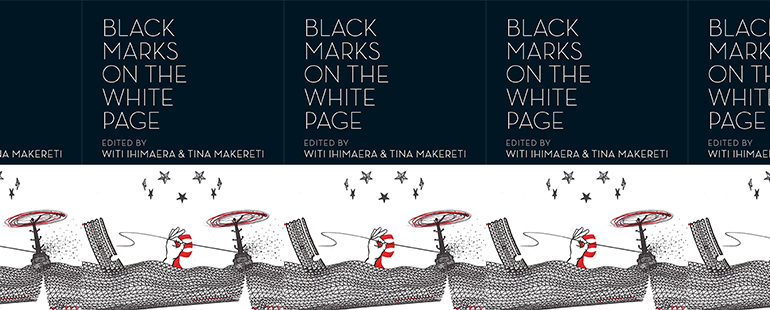Reading Black Marks on the White Page

May is Asian and Pacific Islander heritage month, bringing with it a concerted focus among those in the publishing industry to spotlight writers from these groups. There has, however, been a tendency towards emphasizing Asian American authors during this time, while either adding only a few Pacific Islander authors to reading lists or omitting them altogether. Author T Kira Madden, who identifies as a Pacific Islander, pointed out the dearth of attention such writers receive in a series of tweets in May 2019; while she wasn’t the only author pointing out the frequent omission, her observation led to a number of outlets retracting their original May reading lists and republishing them after adding Pacific Islander authors to the round-ups. This year, Madden tweeted a reminder for readers to “maybe don’t forget the ‘Pacific Islander’ part in every published list this year.” Thankfully, many of the larger media outlets partaking in the celebration have been more mindful about including these key authors in their lists in the past weeks.
As someone from an Asian American background, I have also fallen into the habit of celebrating the stories from those with similar backgrounds to my own. It is easy to let the joy of seeing your own stories being told blind you from recognizing how many stories you are missing. Because of that, I haven’t taken the opportunity to delve into the stories by Pacific Islander authors, though I vowed to change that for this year, starting with Black Marks on the White Page, a collection of short stories by Pacific Islander writers edited by Witi Ihimaera, a Māori writer, and Tina Makereti, a writer of Ngāti Tūwharetoa, Te Āti Awa, Ngāti Rangatahi, Pākehā, and Moriori descent.
The editors draw from a wide array of writers who identify as Pacific Islander, though both Ihimaera and Makereti are quick to push back against conventional boundaries regarding what it means to be Pacific Islander. In the introduction to the collection, they write, “for too long we have all been thinking within boxes constructed by old theoretical maps. In Black Marks on the White Page we have taken a more inclusive approach: we wanted to remember our kinship in the wider Pacific.” This approach widens the imagined boundaries of the Pacific, encompassing stories set in places that might not traditionally be considered part of the Pacific—such as Canada or even parts of East Asia—but are interpreted through the lens of a character who carries the Pacific with them.
The editors also refuse easy formal narrative categorization. Makereti writes, “Witi and I were keen that this collection should recognize the many ways narrative is expressed in the Pacific, to establish our collection of stories within the context of a wider conversation.” The stories collected in Black Marks on the White Page are formally diverse. The first piece in the collection, “Cicada Cingulata: The Bird of Rehua” by Anahera Gildea, is told through the first-person plural, weaving in the personal and cultural in ways that blur the limits of time. Another story, “#Watchlist” by David Geary, is told in a fragmented style cobbled together through bits of dark web chat logs, text conversations, Google searches, and even excerpts from military psychiatric assessments. The collection also includes an excerpt from Aboriginal writer Alexis Wright’s second novel, Carpentaria, “We Mobs Got to Start Acting Locally. Show Whose Got the Dreaming. The Laaaw,” an action-packed glimpse into a scene where a group of men destroy a mine. Ihimaera’s ‘Whakapapa of a Wallpaper: A chimerical fiction” is a beautiful blend of narrative styles and languages, including English, French, and ancient Ariori chant.
One of the key themes in many of these stories is how to depict Pacific Islander identity. As with many indigenous or minority groups in majority-white spaces, writing an identity means not only sharing experiences that are often new for white readers, but also writing against already established stereotypes. For many readers, the term Pacific Islander itself conjures a specific and limited understanding of who falls under that category and what their lifestyle must look like—and what they should therefore be allowed to write about. There is often an expectation for minority groups to write their differences for the white gaze, which can leave little room for individual creativity.
As the collection makes clear, however, those who identify as Pacific Islander come from a wide array of places and experiences. While explicit references to Pacific Islander experiences occur throughout many of the stories, others focus more on the relationships between characters, with setting secondary to the human drama unfolding on the page. “Matariki All-Stars” by Patricia Grace is one such story in the collection; while cultural elements clearly conjure up the setting (such as the mention of kōhanga, or an early childhood class taught in Maori) the focus is on the recent widower, Watson, as he tries to navigate his new role as single-parent to his seven daughters. Culture is an important thread woven throughout the story, as are the struggles of fatherhood and navigating death and loss.
While the stories in Black Marks on the White Page vary in structure and theme, they also differ in the way they present their Pacific Island-ness. Many of the works in the collection include long sections of their authors’ native languages, without the attempt to flatten out their meaning into English, particularly when there is no meaningful equivalent. There is something incredibly powerful in refusing to fit one’s language into the language of the historical colonizer, in choosing to carve out a narrative space for yourself and for those who share the language and culture.
There is also power in shifting stories away from a purely Anglo-centric gaze, reorienting points of reference to encompass cultural elements outside of the bounds of colonialism. In pushing back against the need to “explain themselves,” these writers resist the imposition of the “old theoretical maps” that Ihimaera and Makereti mention in the introduction. Black Marks on the White Page is a stunning exploration of narrative structure, while also showcasing the skills of authors from the wider Pacific. As the editors note, these stories as a way to “redraw the map, rewrite the histories, connect lines across globes that were constructed in the last century, or the one before.”
This piece was originally published on May 25, 2020.


